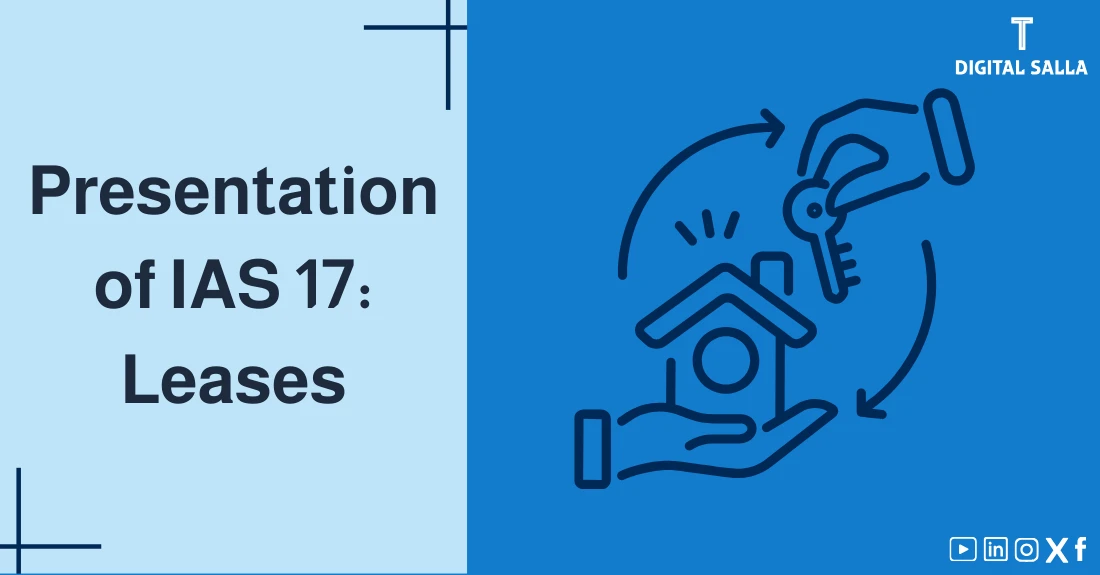Presentation of IAS 17 Standard Leases

IAS 17 Standard, “Leases,” was the primary standard within the International Financial Reporting Standards (IFRS) that governed how to account for leases until the end of 2018. IAS 17 Standard was superseded by IFRS 16, “Leases,” effective January 1, 2019. Although IAS 17 Standard is no longer in effect, understanding it remains important for understanding the evolution of lease accounting and for analyzing companies’ financial statements for prior periods.
In this article, we will provide an overview of IAS 17 Standard, discussing its objectives, scope, and key requirements, focusing on the classification of leases into finance and operating leases, how they were accounted for by both lessees and lessors, as well as highlighting the importance of this standard, its impact on financial statements, and the key differences between it and the new IFRS 16 standard.
What was IAS 17 Standard: Leases?
IAS 17 Standard was an international accounting standard, now superseded, that specified how to account for leases in the financial statements of both lessees and lessors. The standard aimed to ensure that leases were presented fairly in the financial statements and to provide useful information to users of those statements about the impact of leases on an entity’s financial position and financial performance.
Objectives of IAS 17 Standard:
- Determine How to Account for Leases: IAS 17 Standard provided guidance on how to classify, recognize, measure, and present leases in the financial statements.
- Improve the Quality of Disclosures: IAS 17 Standard imposed specific disclosure requirements aimed at improving the transparency and reliability of information related to leases.
- Enhance Comparability: IAS 17 Standard contributed to improving the comparability of financial statements of companies that use leases or lease out assets.
- Provide Useful Information for Decision-Making: IAS 17 Standard helped users of financial statements understand the impact of leases on the entity’s financial position and financial performance.
Scope of IAS 17 Standard:
The standard applied to all leases, except for:
- Lease agreements to explore for or use minerals, oil, natural gas, and similar non-regenerative resources.
- Licensing agreements for items such as motion picture films, video recordings, plays, manuscripts, patents, and copyrights.
Note: IAS 17 Standard was not applied as the basis of measurement for:
- Property held by lessees that was accounted for as investment property (see IAS 40).
- Investment property provided by lessors under operating leases (see IAS 40).
- Biological assets held by lessees under finance leases (see IAS 41).
- Biological assets provided by lessors under operating leases (see IAS 41).
Classification of Leases:
IAS 17 Standard classified leases into two main types:
- Finance Leases:
- Definition: A lease that transfers substantially all the risks and rewards incidental to ownership of an asset to the lessee.
- Accounting Treatment by the Lessee: The lessee recognized the leased asset in the statement of financial position as a fixed asset and also recognized a corresponding liability representing the present value of the lease payments. The asset was depreciated over its useful life, and interest expense was recognized on the liability.
- Accounting Treatment by the Lessor: The lessor derecognized the leased asset from its books and recognized a lease receivable representing the present value of the lease payments. The lessor recognized interest income over the lease term.
- Operating Leases:
- Definition: Any lease other than a finance lease. That is, it does not transfer substantially all the risks and rewards incidental to ownership of the asset to the lessee.
- Accounting Treatment by the Lessee: The lessee recognized lease payments as an expense in the statement of profit or loss over the lease term, usually on a straight-line basis. The lessee did not recognize any asset or liability related to the operating lease in the statement of financial position.
- Accounting Treatment by the Lessor: The lessor retained the leased asset on its books and depreciated it. The lessor recognized lease income over the lease term.
Criteria for Classifying Leases:
IAS 17 Standard provided some criteria to help determine whether a lease was a finance lease or an operating lease. Some of the most important criteria were:
- Transfer of Ownership: If the lease transfers ownership of the asset to the lessee by the end of the lease term, it was a finance lease.
- Bargain Purchase Option: If the lease includes an option for the lessee to purchase the asset at a price significantly below the asset’s fair value at the date the option becomes exercisable, and it was reasonably certain that the lessee would exercise this option, it was a finance lease.
- Lease Term: If the lease term covers the major part of the asset’s economic life, it was a finance lease.
- Present Value of Lease Payments: If the present value of the minimum lease payments amounted to substantially all of the fair value of the asset, it was a finance lease.
- Nature of the Asset: If the asset was of such a specialized nature that only the lessee could use it without major modifications, it was a finance lease.
Disclosure Requirements under IAS 17 Standard:
IAS 17 Standard imposed specific disclosure requirements for both lessees and lessors, aimeds financial position and financial performance.
Key disclosures required from lessees included:
- The carrying amount of assets leased under finance leases for each class of asset.
- A schedule showing the future minimum lease payments under non-cancellable operating leases in aggregate and for each of the following periods: one year, one to five years, and more than five years.
- A description of significant leasing arrangements.
Key disclosures required from lessors included:
- A reconciliation between the gross investment in the finance lease and the net investment in the lease.
- A description of significant leasing arrangements.
- Revenue from operating leases.
Importance of IAS 17 Standard (Before its Supersession):
IAS 17 Standard was an important IFRS that helped companies to:
- Comply with IFRS: IAS 17 Standard specified how to treat leases according to IFRS.
- Fairly Present Leases in Financial Statements: IAS 17 Standard aimed to ensure that leases were presented fairly and transparently in the financial statements.
- Improve the Quality of Financial Information: IAS 17 Standard contributed to improving the quality, relevance, and reliability of financial information related to leases.
- Make Better Decisions: IAS 17 Standard helped management make better decisions about entering into or purchasing leases.
Transition to IFRS 16:
Key Differences between IAS 17 Standard and IFRS 16 from the Lessee’s Perspective:
| Feature | IAS 17 Standard | IFRS 16 |
|---|---|---|
| Lease Classification | Finance and Operating Leases | All leases treated as finance leases (with exceptions) |
| Asset Recognition | Only for finance leases | Right-of-use asset for all leases |
| Liability Recognition | Only for finance leases | Lease liability for all leases |
| Lease Expense | Operating lease expense OR depreciation + interest expense | Depreciation of right-of-use asset + interest expense on lease liability |
| Disclosures | Limited disclosure requirements | More comprehensive disclosure requirements |
Conclusion:
IAS 17 Standard was superseded by IFRS 16, “Leases,” effective January 1, 2019. IFRS 16 introduces a new accounting model for lessees, where all leases (with some exceptions) are recognized on the statement of financial position. IFRS 16 eliminates the previous distinction between finance leases and operating leases from the lessee’s perspective.
Although IAS 17 Standard, “Leases,” has been superseded by IFRS 16, understanding its principles is necessary for analyzing companies’ financial statements for periods when IAS 17 Standard was in effect. IAS 17 Standard aimed to regulate the presentation of leases in financial statements and ensure adequate disclosure of related information. It contributed to improving the quality of financial information related to leases, but it was criticized for not reflecting the economic substance of some leases on the lessee’s statement of financial position. IFRS 16 addressed these criticisms by introducing a new accounting model that requires lessees to recognize assets and liabilities for most leases.
